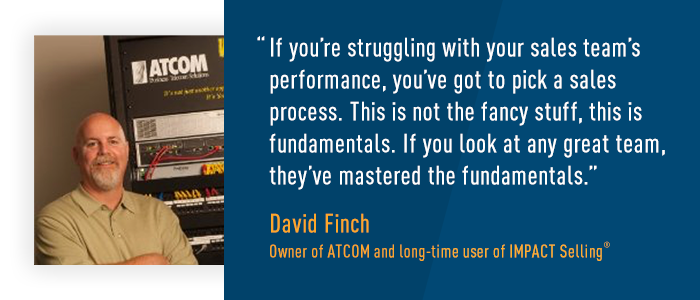Part of improving sales enablement and maintaining a strong customer-focus is being aware of the buyer’s journey and how it aligns with your sales process.
Once your reps are able to connect the two they can:
- Improve the buyer experience
- Build value for your product or service
- Increase win rate, and
- Move prospects more quickly through the sales funnel
What is the Buyer’s Journey?
As your salespeople are progressing through the stages of the sales process, their prospects and customers are on their own path—the buyer’s journey.
The buyer’s journey is the process buyers go through to become aware of, consider and evaluate, and make a decision to purchase a new product or service.
Sales and marketing teams that follow an inbound marketing strategy develop buyer personas, which can help an organization map out the buyer’s journey in detail.
Your buyer’s journey will be unique depending on the solution you provide and your team’s marketing strategy, but most can be generalized as having 3 stages:
- Awareness Stage
- Consideration Stage
- Decision Stage
How to Align Your Sales Process with the Buyer’s Journey
Knowing where a prospect is in the buying process can help the salesperson to ask the right questions, solve the right problems, and move the prospect to the next step of the journey in the sales cycle.
Using a consistent, buyer-focused sales process allows your sales reps to quickly identify where a prospect is on the buyer’s journey, and meet them in the correct step of the selling process. (It can even help them move a prospect backwards, if necessary, which we’ll cover in this post.)
To align your sales process with the buyer’s journey, let’s define what activities or actions the prospect or client is taking during each stage of their journey.
Awareness Stage – The buyer is beginning to realize there is a need or a challenge to be solved
Consideration Stage – The buyer is beginning to research available options and gather necessary info
Decision Stage – The buyer is deciding whether to make a purchase, and if so, from which provider

Steps to Align Your Sales Process with the Buyer’s Journey
Step 1: Begin with the Investigate Step
When a sales rep acquires a lead, their first step should be to begin investigating. This thorough research should be the first stage in any sales process, as it allows a sales rep to gather all available information on leads upfront.
Once the investigation step is complete, your reps will begin initial sales conversations, and should adapt their communication approach to match the prospect’s buying behavior style.
Step 2: Identify Where the Prospect Is in the Buying Journey
Through the questioning stage, your sales professionals can determine where the prospect is in the decision-making process.
Is this a cold call, or a follow-up? Is the prospect actively seeking a solution? Are they comparing options?
Sales leaders should coach their sales team to ask the right sales probing questions to uncover pain points and other relevant information. For example:
“What have you tried in the past, and how has that worked out?”
When a salesperson asks this question, they can determine where the prospect is on the buyer’s journey, and identify any competitors the prospect may have experience with.
Step 3: Move the Buyer Backwards (if necessary) to Make a Collaborative Diagnosis
Most buyers today go through a large portion of the buyer’s journey before ever coming in contact with a salesperson.
This can make a sales rep’s job even harder, because often the prospect has self-diagnosed their issue.
In a perfect world, your prospect and salesperson would work together to collaboratively diagnose the issue – making it easier for your rep to present their solution as the best choice.
If the prospect has already self-diagnosed their issue, coach your reps to raise thought-provoking questions. For example:
Your sales rep is in a conversation with a prospect looking to make a purchase of dental equipment. The prospect has expressed his need for new equipment with the most up-to-date technical features to keep up with the competition.
Your rep might ask,
“Have you considered that the number one request from patients is to be in and out of the dentist office quickly? With that in mind, you may want to take a look at the efficiency of your current equipment…”
A question like this can immediately position the sales rep as a strategic advisor in the buyer’s eyes. It can also move the buyer back in their buyer’s journey to a place where the rep is more in control—and able to add value to your company’s product or service.

From this point, your sales rep and the prospect can make a collaborative diagnosis of the challenge—giving your rep a greater chance of closing the sale. They can focus on selling value, instead of responding to a request for a quote.
The Importance of Aligning Your Sales Process with the Buyer’s Journey
Aligning your sales process with the buyer’s journey helps your reps better connect with potential customers and establish trusting relationships.
If your reps are able to achieve alignment between the two, they’ll better understand how buyers make decisions, and will be able to quickly qualify or disqualify prospects—so they don’t waste time chasing the wrong type of business.
A flexible, buyer-focused sales process like IMPACT allows reps to meet buyers where they are on their purchase journey and interact in a way that enhances their positioning and moves them closer towards the sale.
Read the full ATCOM case study here.
NOTE: Our sales training tools are designed to make your life easier. Use them to your advantage.
The Sales Training Buyer’s Interview Guide
If you’re a sales leader in the market for enterprise-level sales training for your sales organization, chances are you’re busy… very busy. And evaluating sales training providers can be time-consuming, complicated and confusing if you haven’t done it before. In keeping with our commitment to be the go-to practical and commonsense sales training option, we’ve developed The Sales Training Buyer’s Interview Guide.





